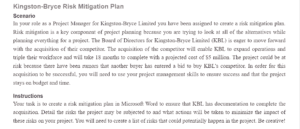Kingston-Bryce Risk Mitigation Plan
Your task is to create a risk mitigation plan in Microsoft Word to ensure that KBL has documentation to complete the acquisition. Detail the risks the project may be subjected to and what actions will be taken to minimize the impact of these risks on your project. You will need to create a list of risks that could potentially happen in the project. Be creative!
The Acquire Project is expected to take 18 months to complete. The allocated budget is worth $5 million. It is expected to expand Kingston-Bryce Limited’s (KBL) workforce up to three times. However, the likelihood of other companies showing interest in the acquisition of KBL’s competitor presents various risks. This plan will detail the risks and the mitigation plans, to ensure seamless acquisition.
Potential Risks
- Delay in completion
- Overpayment
- Unsuccessful acquisition due to price competition
- Cultural class
Risk Avoidance
The acquisition process is not as easy as assumed. Most companies fail to understand the details of the process and lack sufficient reasons for the acquisition. Therefore, it is necessary to put in place specific measures that reduce the risk effects. KBL’s board of directors should detail the reasons for the acquisition and weigh the benefits against the costs. Involving experts is necessary once the business activity is confirmed to be necessary (Perry & Herd, 2004). Experts may involve companies who have gone through the same process. Interviews that provide insight into potential challenges are critical in proper planning. Acquisition experts may also go through the contract that should govern the process and layout aspects related to costs, human resources, or qualifications that may inflate the budget. They will also highlight aspects that are related to legal aspects that may hinder the process. Most importantly, it is critical that KBL’s board of directors starts negotiations with the competitor and includes lawyers for legally binding agreements (Perry & Herd, 2004). Besides, documenting the agreements, including cost, is important in ensuring that other interested parties do not affect the process negatively.
Risk Sharing and Reduction
Thorough due diligence is one of the main avenues that acquirers can use to reduce potential risks. Due diligence provides critical information and verifies the other company’s statements. Lawyers, HR managers, and auditors are critical to the process. The lawyers ascertain the company’s legality and reduce the legal risks that may arise. The HR managers study the company’s cultures and values, which reduces the risk of cultural clashes. As employees merge in the new organization, it will be necessary to create harmony through cultural togetherness. Such information should be availed due to its potential to interfere with the process negatively. Auditors should evaluate the proposed value of the company to avoid overpayment. Collaboration with independent auditors is important for agreement between KBL and its competitor. The due diligence process should be conducted in three stages; preliminary, detailed, and final (IRM INDIA ©, 2020). Each stage achieves different objectives and will prepare KBL for a comprehensive takeover and eliminate most of the risks.
Risk Transfer
Despite thorough due diligence, KBL cannot completely eliminate the possible risks. In this case, it is necessary to engage an insurance company that offers Warranties and Indemnity policies. Such a policy will shield KBL against the competitor’s breach of contract. To share this risk effectively, the competitor should also obtain a policy. The policies are designed to fit the specific transaction. It eliminates the need to set aside money for contingencies in an Escrow account. For efficient coverage, KBL and the competitor must allow the insurance company to access data beforehand (M&A Critique!, 2016).
Conclusion
The acquisition process is important for business growth. However, the risks that are contained herein pose challenges to most companies. In KBL’s case, various procedures have been identified for risk avoidance, reduction, sharing, and transfer. Due diligence is the most important aspect of achieving the three elements of risk mitigation. Obtaining an insurance policy is important in transferring the unavoidable risks.
References
IRM INDIA ©. (2020). Risks in Merger & Acquisition.
M&A Critique! (2016). Risk Transfer Solutions in an M&A transaction.
Perry, J. S., & Herd, T. J. (2004). Mergers and acquisitions: Reducing M&A risk through improved due diligence. Strategy & Leadership, 23(2), 12-19.
ORDER A PLAGIARISM-FREE PAPER HERE
We’ll write everything from scratch
Question
Kingston-Bryce Risk Mitigation Plan
Scenario
In your role as a Project Manager for Kingston-Bryce Limited you have been assigned to create a risk mitigation plan. Risk mitigation is a key component of project planning because you are trying to look at all of the alternatives while planning everything for a project.

Kingston-Bryce Risk Mitigation Plan
The Board of Directors for Kingston-Bryce Limited (KBL) is eager to move forward with the acquisition of their competitor. The acquisition of the competitor will enable KBL to expand operations and triple their workforce and will take 18 months to complete with a projected cost of $5 million. The project could be at risk because there have been rumors that another buyer has entered a bid to buy KBL’s competitor. In order for this acquisition to be successful, you will need to use your project management skills to ensure success and that the project stays on budget and time.
Instructions
Your task is to create a risk mitigation plan in Microsoft Word to ensure that KBL has documentation to complete the acquisition. Detail the risks the project may be subjected to and what actions will be taken to minimize the impact of these risks on your project. You will need to create a list of risks that could potentially happen in the project. Be creative!
Think about examples such as cost, contractual, financial, political, or technical risks that might occur when launching a project. A key point to remember is that risks are broken down into the following broad categories, which should be included in your plan:
- Risk avoidance
- Risk sharing
- Risk reduction
- Risk transfer

